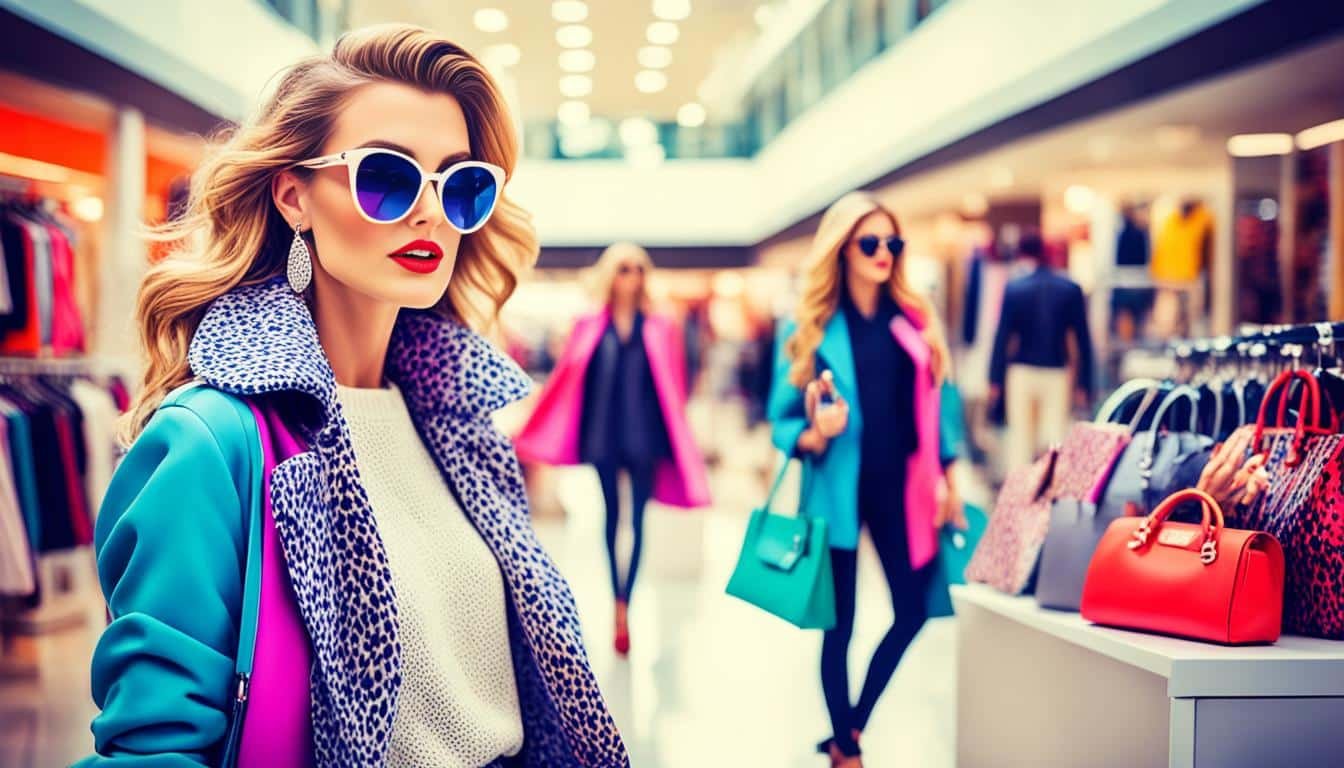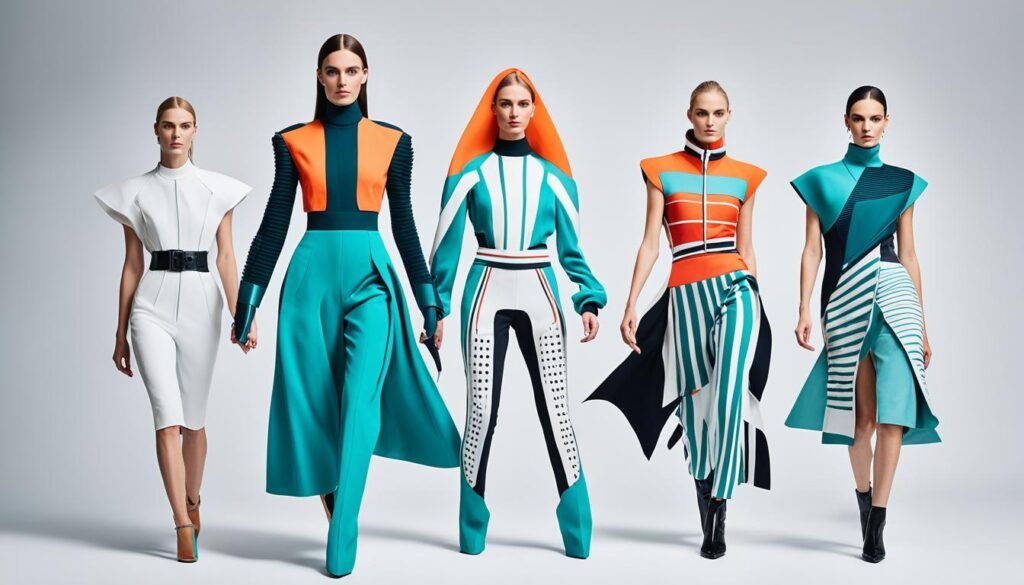Fashion Trends In Shopping the fashion industry is constantly evolving, and staying on top of the latest trends is essential for fashion enthusiasts. In this article, we will delve into the world of fashion trends in shopping, providing insights on this season’s must-haves and offering valuable shopping tips to elevate your style game. From analyzing the latest industry trends to exploring the future of fashion, we will cover a wide range of topics to keep you informed and ahead of the curve.
Key Takeaways: Fashion Trends In Shopping
- Stay up to date with the latest fashion trends to elevate your style game.
- Discover this season’s must-haves to enhance your wardrobe.
- Gain valuable shopping tips to make informed fashion purchases.
- Explore the future of fashion and stay ahead of the curve.
- Incorporate trendy accessories to add a fashionable touch to your outfits.
The Impact of Fashion Trends on the Industry
Fashion trends have a significant impact on the fashion industry. They shape consumer demand, influence the strategies of fashion brands and retailers, and set the tone for fashion weeks and industry events. By understanding the latest trends, fashion companies can cater to consumer preferences and stay relevant in the competitive fashion market. The industry leaders and top fashion retailers constantly monitor trends to develop products and marketing strategies that resonate with their target audience.
When it comes to fashion, staying ahead of the curve is essential. The fashion industry thrives on innovation and creativity, and identifying and anticipating fashion trends is key to succeeding in this dynamic market. By keeping a close eye on emerging trends, fashion brands can stay one step ahead and capture the attention of consumers.
“Fashion is the armor to survive the reality of everyday life.”
The evolution of fashion trends is driven by a variety of factors, including cultural shifts, celebrity influence, and changing consumer preferences. These trends influence not only the design and production of clothing and accessories but also the overall direction of the fashion market.
Additionally, fashion trends play a vital role in defining and shaping consumer identities. They allow individuals to express themselves and create unique personal styles. By following the latest trends, people can embrace new looks and experiment with different fashion choices, ultimately boosting their confidence and self-expression.
Fashion Brands and Industry Trends
For fashion brands and retailers, understanding and incorporating fashion trends is essential for success. By aligning their product offerings with the latest trends, brands can attract and retain customers who are looking to stay fashionable and current.
Industry leaders and top fashion retailers closely monitor trends through various sources, such as fashion shows, trend reports, street style, and social media. This allows them to identify emerging styles, colors, patterns, and silhouettes that are likely to become popular among consumers.
Once the trends are identified, fashion brands and retailers adapt their product lines to reflect these changes. This includes designing new collections, selecting fabrics and materials, and incorporating the latest trends into their marketing and branding efforts. By doing so, they can cater to consumer demands and maintain their position in the competitive fashion market.
| Fashion Trends | Impact on the Industry |
|---|---|
| Minimalism | Encouraged the use of clean lines, neutral colors, and simplicity, influencing the design aesthetics of many fashion brands. |
| Genderless Fashion | Brought a new dimension to the industry, blurring traditional gender boundaries and challenging societal norms. |
| Streetwear | Popularized a casual and comfortable style, transforming the fashion industry and shaping the clothing choices of consumers. |
The Rise of Fast Fashion and Its Influence on Shopping Habits
Fast fashion has revolutionized the fashion industry and transformed consumer shopping habits. With its ability to quickly replicate runway looks at affordable prices, fast fashion brands have gained popularity among fashion enthusiasts. This has led to an increase in online shoppers and a shift in consumer demand for trendy and affordable clothing. However, the rise of fast fashion has also raised concerns about its impact on the environment and labor practices, prompting consumers to seek more sustainable alternatives.
In today’s fast-paced world, consumers are driven by the need to stay on top of the latest trends and constantly update their wardrobes. Fast fashion brands have tapped into this consumer demand by offering a wide range of fashionable clothing options at affordable prices. They are able to quickly produce and distribute new designs, making trendy pieces accessible to a larger audience. As a result, online shoppers have embraced fast fashion, enjoying the convenience of browsing and purchasing trendy clothing from the comfort of their homes.
Shopping for fashion has become more than just a transaction. It has evolved into a personalized experience influenced by the fast fashion movement. Online shoppers expect a seamless and enjoyable shopping experience coupled with affordable and trendy clothing options. Fast fashion brands have responded by investing in user-friendly websites and mobile apps, providing personalized recommendations based on individual preferences and purchase history. The integration of technology has enhanced the overall shopping experience, making it more convenient and satisfying for consumers.
“The rise of fast fashion has transformed the way we shop for clothing. It has democratized fashion, making trendy pieces accessible to a wider audience. However, we need to be mindful of the environmental and ethical consequences of our shopping habits and look for more sustainable alternatives.”
While fast fashion has brought accessibility and affordability to the forefront, it has also raised concerns about its impact on the environment and labor practices. The nature of fast fashion production often involves large-scale manufacturing, which can contribute to waste and pollution. Additionally, there have been reports of unethical labor practices within the fast fashion industry. These concerns have prompted consumers to seek more sustainable alternatives, such as shopping from ethical and eco-friendly fashion brands.
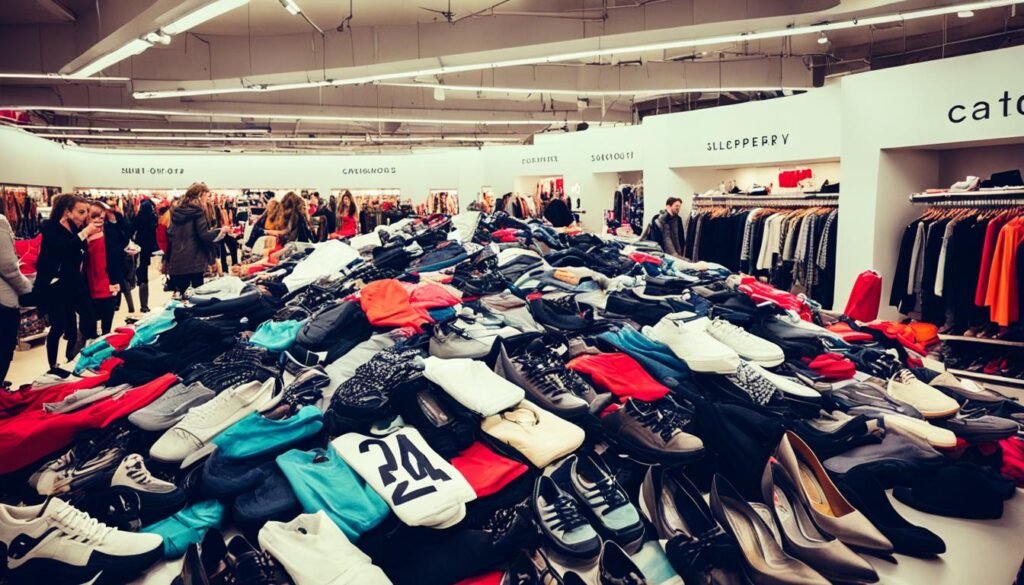
| Fast Fashion | Consumer Demand | Fashion Retail | Online Shoppers | Shopping Experience |
|---|---|---|---|---|
| Offers trendy and affordable clothing | Driven by the desire to stay on top of trends | Leverages technology to enhance the shopping experience | Embraces online shopping for convenience | Focused on fast-paced fashion updates |
| Raises concerns about environmental impact | Raises demand for sustainable alternatives | Challenges traditional retail models | Shifts consumer behavior towards online shopping | Transforms shopping into a personalized experience |
As consumer awareness regarding the environmental and ethical impacts of fast fashion continues to grow, the fashion industry is gradually embracing a more sustainable approach. Many fashion brands are implementing responsible sourcing practices, using eco-friendly materials, and focusing on reducing waste throughout the supply chain. Consumers, in turn, are actively seeking out sustainable fashion options and supporting brands with transparent and ethical practices.
The rise of fast fashion has undoubtedly shaped shopping habits, offering trendy and affordable clothing at the click of a button. However, as consumers, it is important to be mindful of the consequences of our purchasing decisions. By staying informed, exploring sustainable alternatives, and demanding transparency from fashion brands, we can make conscious choices that align with our values and contribute to a more sustainable fashion industry.
The Role of Influencers in Shaping Fashion Trends
Influencers have emerged as powerful trendsetters in the fashion industry. With their extensive presence on popular social media platforms like Instagram and TikTok, influencers possess the ability to reach vast audiences and impact consumer purchasing decisions in significant ways. By leveraging their influence, they play a critical role in shaping fashion trends and driving consumer demand.
Through their carefully curated content and engaging storytelling, influencers possess the power to showcase the latest fashion items in unique and relatable ways. With their fashion-forward aesthetics and personal styles, influencers provide inspiration to their followers and help them stay on top of the ever-changing fashion landscape.
One of the key ways influencers shape fashion trends is through influencer marketing. This marketing strategy involves brands and retailers collaborating with influencers to promote their products and connect with consumers in a more authentic and organic manner. By aligning with influencers whose personal styles align with their target audience, fashion brands can leverage the influencers’ influence to reach new customers and effectively resonate with their consumer base.
Social media platforms have become breeding grounds for fashion trends, and influencers are at the forefront of this revolution. Their ability to connect and engage with their followers on these platforms allows influencers to disseminate fashion trends quickly and effectively, making them early adopters and trendsetters in the industry.
Moreover, influencers offer personalized recommendations to their followers, making them trusted sources of fashion advice and guidance. Their opinions carry weight and influence consumer decisions, driving up the demand for specific fashion items and styles.
Statistical data reflects the immense impact of influencers on consumer behavior. According to a recent study conducted by FashionNova, 80% of consumers stated that they have made a purchase based on an influencer’s recommendation, and 70% of millennials reported that they trust online influencers more than traditional celebrities.
As influencers continue to shape fashion trends through their online presence, their influence is only expected to grow in the coming years. Brands and retailers are increasingly recognizing the power of influencer marketing and are incorporating it into their marketing strategies to tap into the broad reach and engagement of influencers.
The Power of Influencer Collabs
In addition to directly influencing fashion trends, influencers have become collaborators and partners with brands to design and release their fashion lines. These collaborations allow both parties to leverage their respective audiences and combine their unique aesthetic and influence to create exclusive fashion collections. Such collaborations have proven to be immensely successful, with limited-edition influencer collections flying off the shelves and creating a buzz in the fashion industry.
The Future of Influencer Marketing
As influencer marketing continues to evolve, it is expected that influencers will play an increasingly crucial role in shaping fashion trends. With the emergence of new social media platforms and the evolving preferences of the digital-savvy consumer base, influencers are poised to remain at the forefront of fashion trends, driving consumer demand and ultimately impacting the fashion industry as a whole.
| Influencer | Social Media Platform | Followers (in millions) |
|---|---|---|
| Kylie Jenner | 249 | |
| Addison Rae | TikTok | 116 |
| PewDiePie | YouTube | 110 |
| Gigi Hadid | 69 | |
| Ryan Reynolds | 37 |
The Integration of Technology in the Shopping Experience
Technology has revolutionized the way we shop, bringing convenience, personalization, and innovation to the forefront. With the rise of augmented reality (AR), mobile apps, and personalized recommendations, the shopping experience has undergone a significant transformation.
Augmented Reality: Trying On Clothes Virtually
One of the most exciting advancements in technology is the integration of augmented reality in the shopping experience. AR allows customers to virtually try on clothes before making a purchase, eliminating the need to physically visit a store and providing a more immersive online shopping experience. By simply using their smartphone or computer, customers can see how a particular garment will look on them, helping them make more informed decisions and reducing the hassle of returns.
With augmented reality, shoppers can visualize the fit, color, and style of clothing items, enabling them to confidently make purchases without the traditional limitations of online shopping. This technology has revolutionized the way consumers interact with fashion, enabling them to explore and experiment with different styles from the comfort of their homes.
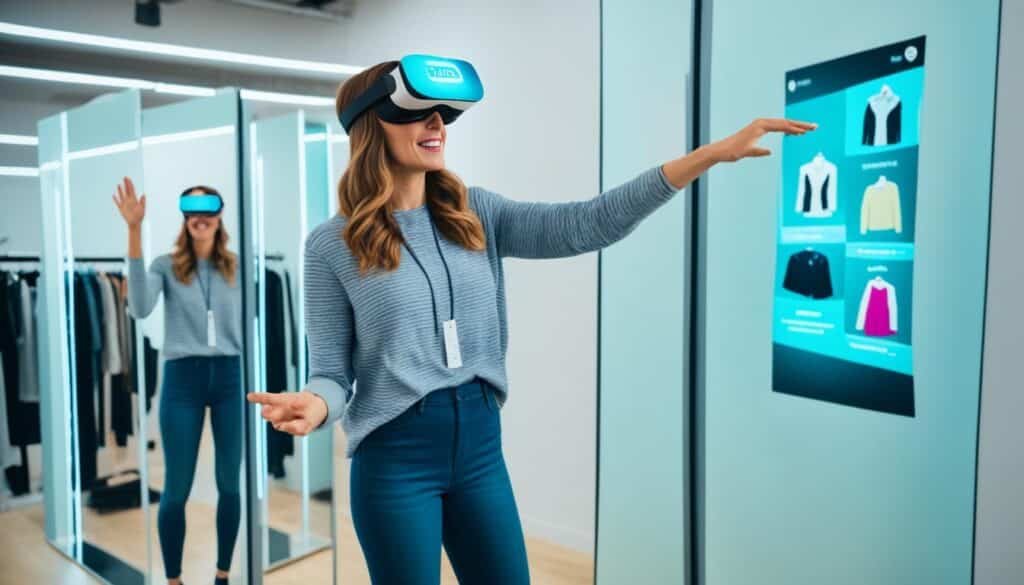
Mobile Apps: Personalized Recommendations at Your Fingertips
Mobile apps have become an integral part of the shopping experience, offering personalized recommendations tailored to each user’s preferences, browsing history, and purchase behavior. Using advanced algorithms and machine learning, these apps analyze customer data to curate a selection of products that align with their individual style and preferences.
With personalized recommendations, shoppers can discover new styles and brands that they may not have considered, expanding their fashion horizons and staying on top of the latest trends. Whether it’s suggesting similar items based on a previous purchase or providing outfit suggestions based on the current weather, these apps enhance the overall shopping experience, making it more efficient and enjoyable.
Online and Offline Integration: Seamlessly Blending the Worlds
The integration of online and offline channels has become increasingly important in the shopping experience. Customers now have the flexibility to browse and purchase items both online and in physical stores, creating a seamless shopping journey. This omnichannel approach allows shoppers to experience the best of both worlds, taking advantage of the convenience of online shopping while still enjoying the tactile experience of trying on clothes in-store.
For example, customers can browse online, add items to their cart, and then visit the physical store to try them on before making a final purchase decision. Similarly, customers can discover products in-store and make the purchase online for added convenience. This integration offers convenience, choice, and flexibility to shoppers, catering to their individual preferences and maximizing their satisfaction.
Technology has truly transformed the shopping experience, empowering consumers with augmented reality, personalized recommendations, and online and offline integration. As technology continues to advance, we can expect even more exciting developments in the future, with the potential to further enhance the way we shop and interact with fashion.
The Future of Fashion: Trends Shaping the Industry
The fashion industry is constantly evolving, with new trends emerging each year. In 2024, several key trends are expected to shape the industry, reflecting the changing preferences of consumers and the industry’s commitment to creating a more inclusive and environmentally conscious fashion market.
Inclusivity and Diversity
One of the major trends shaping the future of fashion is the focus on inclusivity and diversity. Fashion brands are recognizing the importance of catering to a diverse range of body types, ethnicities, and genders. Inclusivity and diversity are no longer just buzzwords; they have become integral values in the fashion industry. Fashion brands that embrace inclusivity and diversity are not only increasing their customer base but also fostering a more inclusive and representative fashion culture.
Integration of Technology in Fashion Products
The integration of technology in fashion products is another significant trend in the industry. As technology continues to advance, fashion brands are incorporating innovative features into their products. From smart clothing that monitors health and fitness to wearable tech accessories, technology is revolutionizing the way we interact with fashion. In 2024, we can expect to see even more cutting-edge fashion products that seamlessly blend style and technology.
Rise of Sustainable Fashion Practices
Sustainable fashion practices have gained momentum in recent years, and this trend is set to continue in 2024. Consumers are becoming more conscious of the environmental impact of the fashion industry and are seeking sustainable alternatives. Fashion brands are responding to this demand by adopting eco-friendly materials, implementing ethical manufacturing processes, and embracing circular fashion initiatives. The rise of sustainable fashion is not only a reflection of consumer preferences but also an acknowledgment of the industry’s responsibility to protect the planet for future generations.
In summary, the future of fashion is an exciting and dynamic landscape. The industry is evolving to embrace inclusivity and diversity, integrate technology into fashion products, and prioritize sustainability. By staying informed about these key trends, fashion enthusiasts can navigate the ever-changing fashion market and make conscious choices that align with their values.
The Influence of Luxury Fashion on Shopping Trends
When it comes to shaping shopping trends, luxury fashion has a profound impact on the fashion market. Renowned fashion designers and prestigious luxury brands set the bar for high fashion, influencing the industry as a whole. Their exquisite creations not only capture the attention of fashion enthusiasts but also inspire and shape the wider fashion market.
The allure of luxury fashion lies in its exclusivity and craftsmanship. Each piece is meticulously crafted with attention to detail, showcasing the designer’s unique vision and artistic expression. These extraordinary creations often become coveted items that fashion enthusiasts aspire to own.
Luxury fashion sets the tone for new trends, introducing innovative designs and styles that filter down to influence mainstream fashion. Fashion enthusiasts look to luxury brands and fashion designers as trendsetters, seeking inspiration and guidance to elevate their personal style.
Take, for example, the iconic and timeless designs by renowned luxury brands such as Chanel, Gucci, and Louis Vuitton. The innovative designs and exquisite craftsmanship of these fashion powerhouses have a ripple effect on the fashion market, inspiring and influencing the creation of similar styles by other brands.
The influence of luxury fashion on shopping trends extends beyond the garments themselves. Accessories, such as designer handbags and shoes, also play a significant role in shaping fashion trends. These luxury accessories not only enhance an outfit but also serve as status symbols, symbolizing sophistication, elegance, and discerning taste.
“Luxury fashion has the power to ignite desire and shape shopping trends. The allure of exclusivity, impeccable craftsmanship, and timeless designs create a lasting impact on the fashion market.” – Your Name
In summary, luxury fashion brands and designers have a profound influence on shopping trends. Their creations set the bar for high fashion and trickle down to inspire and shape the wider fashion market. The exclusivity, craftsmanship, and innovative designs associated with luxury fashion create a unique appeal that continues to captivate fashion enthusiasts and shape the industry as a whole.
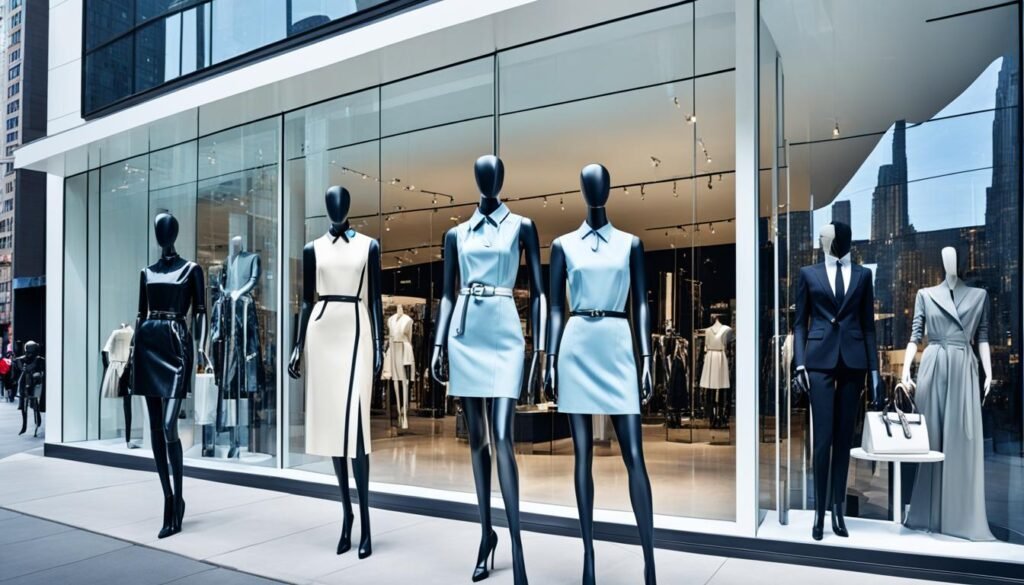
Popular Luxury Fashion Designers
| Designer | Brand |
|---|---|
| Giorgio Armani | Armani |
| Coco Chanel | Chanel |
| Christian Dior | Dior |
| Alexander McQueen | McQueen |
| Tom Ford | Tom Ford |
The Importance of Customer Experience in Fashion Retail
Customer experience holds immense significance in the world of fashion retail. Brands and retailers must prioritize providing a seamless and personalized shopping experience that surpasses customer expectations. By understanding and catering to customer demands, fashion retailers can build strong connections and create loyal customers who keep coming back.
In 2024, several key customer experience trends are expected to shape the fashion retail landscape. These trends include:
- The use of artificial intelligence (AI) to enhance personalization: AI technologies can analyze customer data to deliver tailored recommendations and personalized shopping experiences. By leveraging AI, fashion retailers can curate unique offerings that resonate with individual customers’ preferences and style.
- The integration of social media platforms for customer engagement: Social media has become a powerful tool for fashion retailers to engage with customers. By utilizing platforms such as Instagram, Facebook, and TikTok, brands can connect with their target audience on a more personal level, share fashion inspiration, and gather valuable feedback.
- The emphasis on creating connections with consumers both online and offline: Creating meaningful connections with customers is crucial for fashion retailers. This can involve initiatives such as hosting in-store events, offering personalized styling sessions, and providing exceptional customer service. By focusing on building relationships, retailers can foster brand loyalty and customer satisfaction.
By incorporating these customer experience trends into their strategies, fashion retailers can stay ahead of the curve and meet the evolving demands of their target audience. The ability to deliver exceptional customer experiences will not only result in increased customer satisfaction but also drive long-term business growth.
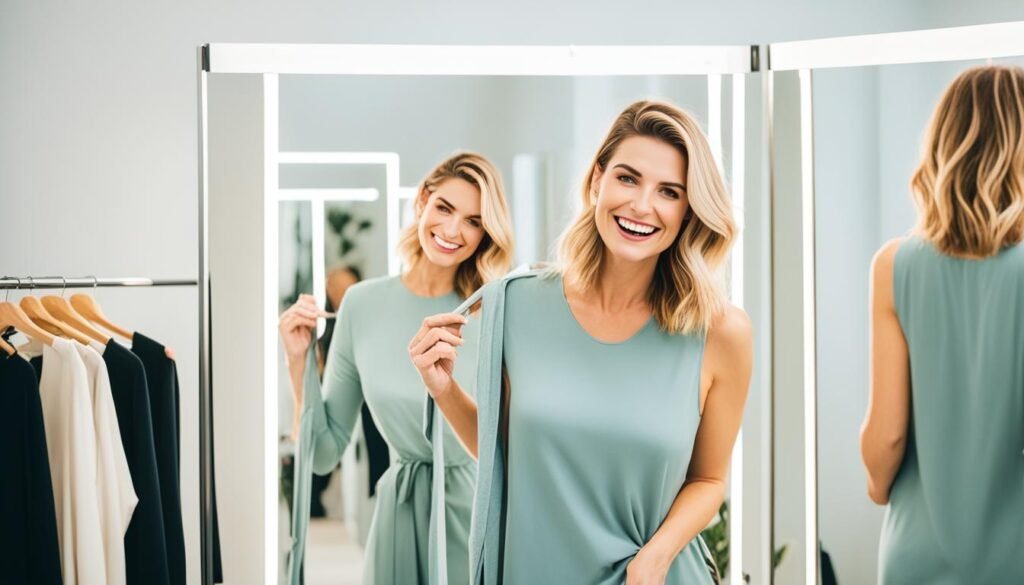
Image: A visual representation of a fashion retail store with customers engaging in a personalized shopping experience.
The Role of Sustainability in Fashion Trends
Sustainability has become a prominent trend in the fashion industry. Brands and retailers are adopting eco-friendly materials and practices, and consumers are increasingly demanding sustainable fashion options. This shift towards sustainability is not only driven by environmental concerns but also by the recognition of the potential long-term benefits for both the fashion industry and society as a whole.
One of the key areas where sustainability is making an impact is in the supply chain. Fashion brands are increasingly looking for ways to reduce their carbon footprints and minimize the environmental impact of their operations. This includes using renewable energy sources, implementing efficient waste management systems, and adopting sustainable manufacturing processes.
Moreover, the adoption of fair labor practices in the fashion industry is gaining momentum. Brands are recognizing the importance of ensuring the well-being and fair treatment of workers throughout the supply chain, including those involved in the production of raw materials and the manufacturing of garments. This commitment to fair labor practices is not only ethically responsible but also helps to create a more sustainable and socially responsible fashion industry.
The use of eco-friendly materials is another significant aspect of the sustainability trend in fashion. From organic cotton and recycled polyester to innovative materials made from agricultural waste or biodegradable fabrics, fashion brands are exploring and implementing materials that have a lower environmental impact.
| Sustainability Initiatives | Benefits |
|---|---|
| Reducing carbon footprints | Minimizes the environmental impact of fashion operations |
| Implementing fair labor practices | Ensures the well-being and fair treatment of workers |
| Using eco-friendly materials | Reduces the environmental impact of fashion production |
The demand for sustainable fashion options is being driven by increasingly environmentally conscious consumers. People are becoming aware of the negative effects of fast fashion on the environment and are seeking alternatives that align with their values. Through their purchasing decisions, consumers are sending a strong message to fashion brands and retailers that sustainability matters.
As sustainability continues to shape fashion trends, it is encouraging to see the industry’s commitment to positive change. By embracing eco-friendly practices, adopting sustainable materials, and ensuring fair labor practices, the fashion industry is taking significant steps towards a more sustainable future.
The Impact of Fashion Weeks on Shopping Trends
Fashion weeks are major events in the fashion industry that showcase the latest trends and collections from top fashion brands. These highly anticipated events not only influence the fashion industry as a whole, but also have a significant impact on shaping shopping trends for fashion enthusiasts and consumers.
Also Read:- Top 10 Online Shopping Sites: Your Guide To The Best E-commerce Platforms Of 2024
During fashion weeks, designers and fashion brands present their new collections on the runway, highlighting the upcoming trends in clothing, accessories, and styling. These runway shows serve as a platform for fashion enthusiasts and industry professionals to get a glimpse of what’s to come in the world of fashion.
One of the key highlights of fashion weeks is street style. Fashion enthusiasts and influencers attending these events, showcase their unique and creative personal style, serving as a source of inspiration for fashion lovers around the world. Street style photographs captured during fashion weeks often go viral, setting the tone for upcoming trends and shaping the way people dress and shop.
The coverage and buzz generated during fashion weeks have a ripple effect on the fashion industry. The media, fashion publications, and social media platforms are abuzz with discussions, trend analyses, and reviews of the latest collections. This creates excitement and anticipation among fashion enthusiasts, prompting them to seek out the latest trends and shop for new additions to their wardrobes.
“Fashion weeks have a profound impact on shopping trends, influencing not only what people wear but also how they express themselves through fashion.”
Fashion brands capitalize on the popularity and coverage of fashion weeks by releasing new collections into the market shortly after the runway shows. This strategic timing ensures that the trends showcased on the runways are fresh in the minds of consumers, sparking their desire to own and wear the latest fashion pieces.
The influence of fashion weeks on shopping trends extends beyond the fashion industry itself. Retailers, both online and offline, take cues from the runway shows and street style to curate their own collections and promotions. They strive to provide their customers with the latest fashion trends, allowing them to stay on-trend and express their personal style.
In conclusion, fashion weeks play a pivotal role in shaping shopping trends. From the runway shows to street style and media coverage, these events create a buzz that influences fashion enthusiasts and consumers alike. By being aware of the trends showcased during fashion weeks, fashion enthusiasts can stay ahead of the curve and make informed fashion purchases, all while expressing their personal style.
The Importance of Personal Style in Shopping
In the world of fashion, trends come and go, but personal style is timeless. While following the latest fashion trends can be exciting and give you a sense of staying on top of the fashion game, it’s equally important to stay true to your own unique sense of style. Your personal style is a reflection of your individuality and can set you apart from the crowd.
When incorporating fashion trends into your wardrobe, it’s essential to do so in a way that aligns with your personal style. You don’t have to completely overhaul your wardrobe with each new trend that emerges. Instead, choose pieces that resonate with you and complement your existing style.
Understanding your personal style is the key to making intentional fashion purchases. Take the time to explore different styles, experiment with different silhouettes and colors, and pay attention to what makes you feel confident and comfortable. Whether you prefer a classic, minimalistic look or love to embrace bold, eclectic fashion choices, your personal style should always shine through.
By staying true to your personal style while incorporating fashion trends, you create a wardrobe that is a true reflection of yourself. Remember, fashion trends may come and go, but your personal style will always remain constant.
Discovering and embracing your personal style is an ongoing journey. It’s about finding what makes you feel the most authentic and confident in your own skin. So next time you go shopping, keep your personal style in mind and choose pieces that truly speak to you.
The Benefits of Embracing Personal Style:
- Expressing Individuality: By embracing personal style, you have the opportunity to express your unique personality and stand out from the crowd.
- Confidence Booster: When you feel comfortable in what you wear, it boosts your confidence and makes you feel more self-assured.
- Timeless Wardrobe: By focusing on your personal style rather than chasing trends, you build a wardrobe that transcends seasons and remains relevant for years to come.
- Efficient Shopping: Knowing your personal style helps streamline the shopping process. You can easily identify pieces that align with your style, saving time and money.
- Long-term Satisfaction: When you invest in pieces that reflect your personal style, you’re more likely to wear them consistently and feel satisfied with your fashion choices.
Remember, fashion is a form of self-expression, and embracing personal style allows you to curate a truly one-of-a-kind wardrobe that reflects your unique fashion sense. So, as you navigate the ever-evolving world of fashion, stay true to yourself and let your personal style shine through.
Conclusion
Fashion trends in shopping play a significant role in shaping the fashion industry and influencing consumer purchasing decisions. Staying up to date with the latest trends is essential for fashion enthusiasts who want to elevate their style game and make informed fashion purchases. By following the latest industry trends and embracing personal style, individuals can navigate the ever-changing world of fashion while staying true to their own unique preferences.
Incorporating trendy accessories and staying aware of seasonal fashion trends allows individuals to create a fashionable wardrobe that reflects their personal style and keeps them ahead of the curve. It’s important to consider sustainability in fashion choices and embrace new technologies to enhance the overall shopping experience. By doing so, fashion enthusiasts can have a more satisfying and fulfilling fashion journey.
Whether it’s staying updated on the latest fashion trends in shopping, incorporating trendy accessories, or following shopping tips, the key is to find a balance between embracing current trends and staying true to personal style. By doing this, individuals can confidently navigate the fashion landscape and express their unique fashion sense while making stylish and informed fashion purchases.
FAQs
Q: What are the top trends in fashion for 2024?
A: The top trends for 2024 include monochromatic outfits, trench coats, sneaker culture, and high fashion brands like Gucci and Balenciaga.
Q: How can I stay updated on the latest fashion industry trends?
A: You can stay updated on the latest fashion industry trends by following leading fashion publications such as Vogue, Business of Fashion, and McKinsey’s State of Fashion report.
Q: What is the significance of street style in the fashion industry?
A: Street style has become an important aspect of the fashion industry, influencing trends and serving as a platform for showcasing individuality and creativity.
Q: Why are trench coats considered a timeless fashion piece?
A: Trench coats are considered timeless because they have been a staple in fashion for decades, offering both style and function in various fashion trends.
Q: How are fashion trends for 2024 different from previous years?
A: Fashion trends for 2024 may focus on new elements such as blockchain technology, sustainability, and metaverse integration, setting them apart from trends in previous years.
Q: What role do sneakers play in shaping contemporary fashion trends?
A: Sneakers have evolved from sports footwear to iconic fashion statements, influencing street style and high fashion collections, making them a key trend in the industry.
Q: How do high fashion brands like Balenciaga contribute to setting fashion trends?
A: High fashion brands like Balenciaga set trends by showcasing innovative designs, collaborating with influencers, and creating buzz around their collections, influencing the industry.
